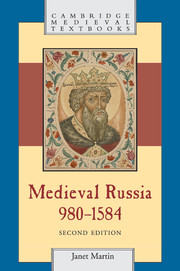Book contents
- Frontmatter
- Contents
- List of illustrations
- Acknowledgments
- Note on names, dates, and transliteration
- Chronology
- List of abbreviations
- 1 The era of Vladimir I
- 2 Princes and politics (1015–1125)
- 3 Kievan Rusˈ society
- 4 Kievan Rusˈ: the final century
- 5 The Golden Horde
- 6 The Russian lands within the Golden Horde
- 7 The Daniilovich ascension
- 8 The unification and centralization of Muscovy
- 9 Muscovite domestic consolidation
- 10 Foreign policy and foreign trade
- 11 Ivan IV the Terrible
- 12 Conclusions and controversies
- Select bibliography
- Index
- Cambridge Medieval Textbooks
8 - The unification and centralization of Muscovy
Published online by Cambridge University Press: 05 June 2012
- Frontmatter
- Contents
- List of illustrations
- Acknowledgments
- Note on names, dates, and transliteration
- Chronology
- List of abbreviations
- 1 The era of Vladimir I
- 2 Princes and politics (1015–1125)
- 3 Kievan Rusˈ society
- 4 Kievan Rusˈ: the final century
- 5 The Golden Horde
- 6 The Russian lands within the Golden Horde
- 7 The Daniilovich ascension
- 8 The unification and centralization of Muscovy
- 9 Muscovite domestic consolidation
- 10 Foreign policy and foreign trade
- 11 Ivan IV the Terrible
- 12 Conclusions and controversies
- Select bibliography
- Index
- Cambridge Medieval Textbooks
Summary
Much of the dynamic that drove the domestic politics of the Rusˈ principalities from the eleventh through the fourteenth centuries derived from intradynastic relations and concern over succession to the grand princely throne. Before the Mongol invasion, the position of grand prince of Kiev had been the focal point of dynastic politics. After the Mongol invasion and the eventual absorption of the southwestern Rusˈ principalities, including Kiev, into Lithuania and Poland, the role of grand prince of Vladimir assumed a parallel significance for the northeastern Riurikid princes, the descendants of Prince Iaroslav Vsevolodich (d. 1246). Within the northeastern Rusˈ principalities dynastic tensions continued to shape domestic politics. Defenders of the eroding principles that defined legitimacy and determined the successors to the grand princely seat struggled with the Daniilovichi, whose ascendancy denoted the replacement of those principles by the authority of the khan of the Golden Horde.
By the end of the fourteenth century, the Daniilovich princes, more specifically the descendants of Ivan I Kalita, had monopolized the position of grand prince of Vladimir. By the time Vasily I claimed the throne in 1389, the only murmur of dynastic disagreement came from his father's cousin, Vladimir Andreevich of Serpukhov, who was, as Dmitry Donskoi had been, a grandson of Kalita. Although it is not clear that Prince Vladimir, whose own father Andrei had died in 1353, was challenging Vasily's claim to the throne, the rapid resolution of their dispute effectively confirmed that the field of eligible princes for the grand princely throne had narrowed further to the descendants of Dmitry Donskoi.
- Type
- Chapter
- Information
- Medieval Russia, 980–1584 , pp. 261 - 297Publisher: Cambridge University PressPrint publication year: 2007

